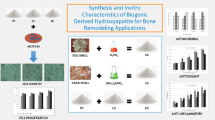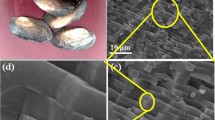Abstract
Bone fillers based on hydroxyapatite (HAp) having antimicrobial activity are extensively applied for treatment of bone-related inflammation created by infectious micro-organisms. We report the biogenic preparation of HAp nanorods with the aid of Curcuma longa tuber extract as solvent and eggshell biowaste as a calcium source. The prepared powder was analyzed by various analytical tools to explore the phase purity and morphological feature. The obtained results indicate that the prepared powder was magnesium (Mg) and carbonate (CO32−) containing HAp nanorods having nanocrystalline characteristics. Further, the prepared HAp nanorods significantly hinder the growth of E. coli and S. aureus. Comparative studies were also carried out with HAp prepared using water as solvent. The obtained results clearly shows that developed method can be a prospective approach to acquire precursor material for making bone fillers with antibacterial activity.

Hydroxyapatite (HAp) nanorods with antibacterial activity were prepared by simple biogenic synthesis using Curcuma longa tuber extract, eggshell, and Na2HPO4 as the source for the treatment of bone infections in orthopedics.








Similar content being viewed by others
References
Ramakrishna S, Murugan R, Kumar TSS, Soboyejo WQ (2010) Biomaterials: a nano approach. CRC Press, USA
Vallet-Regi M, Arcos DA (2008) Biomimetic nanoceramics in clinical use: from materials to applications. RSC Publishing, UK
Mucalo M (2015) Hydroxyapatite (HAp) for biomedical applications. Elsevier, Canada
Suchanek W, Yoshimura M (1998) Processing and properties of hydroxyapatite-based biomaterials for use as hard tissue replacement implants. J Mater Res 13:94
Kumar GS, Govindan R, Girija EK In situ synthesis, characterization and in vitro studies of ciprofloxacin loaded hydroxyapatite nanoparticles for the treatment of osteomyelitis. J Mater Chem B 2:5052–5060
Le HR, Chen KY, Wang A (2012) Effect of pH and temperature on the morphology and phases of co-precipitated hydroxyapatite. J Sol-Gel Sci Technol 61:592–599
Sadat-Shojai M, Khorasani MT, Dinpanah-Khoshdargi E, Jamshidi A (2013) Synthesis methods for nanosized hydroxyapatite with diverse structures. Acta Biomater 9:7591–7621
Sánchez-Salcedo S, Vila M, Diaz A, Acosta C, Barton I, Escobar A, Vallet-Regí M (2016) Synthesis of HA/β-TCP bioceramic foams from natural products. J Sol-Gel Sci Technol 79:160–166
Kumar GS, Sathish L, Govindan R, Girija EK (2015) Utilization of snail shells to synthesise hydroxyapatite nanorods for orthopedic applications. RSC Adv 5:39544–39548
Rocha JHG, Lemos AF, Agathopoulos S, Valério P, Kannan S, Oktar FN, Ferreira JMF (2005) Scaffolds for bone restoration from cuttlefish. Bone 37:850–857
Siddharthan A, Kumar TSS, Seshadri SK (2009) Synthesis and characterization of nanocrystalline apatites from eggshells at different Ca/P ratios. Biomed Mater 4:045010
Guru PS, Dash S (2014) Sorption on eggshell waste—a review on ultrastructure, biomineralization and other applications. Adv Colloid Interface Sci 209:49–67
Hamilton RMG (1986) The microstructure of the hen’s egg shell—A short review. Food Micro 5:99–110
Lew DP, Waldvogel FA (2004) Osteomyelitis. Lancet 364:369–379
Rameshbabu N, Kumar TSS, Prabhakar TG, Sastry VS, Murty KV, Rao KP (2007) Antibacterial nanosized silver substituted hydroxyapatite: synthesis and characterization. J Biomed Mater Res A 80:581–591
Nathanael AJ, Lee JH, Mangalaraj D, Hong SI, Rhee YH (2012) Multifunctional properties of hydroxyapatite/titania bio-nano-composites: bioactivity and antimicrobial studies. Powder Technol 228:410–415
Gopi D, Bhuvaneshwari N, Indira J, Kanimozhi K, Kavitha L (2013) A novel green template assisted synthesis of hydroxyapatite nanorods and their spectral characterization. Spectrochim Acta Part A Mol Bimol Spectrosc 107:202–196
Kumar GS, Rajendran S, Karthi S, Govindan R, Girija EK, Karunakaran G, Kuznetsov D (2017) Green synthesis and antibacterial activity of hydroxyapatite nanorods for biomedical applications. MRS Commun 7:183–188
Kanchana P, Sudhan N, Anandhakumar S, Mathiyarasu J, Manisankar P, Sekar C (2015) Electrochemical detection of mercury using biosynthesized hydroxyapatite nanoparticles modified glassy carbon electrodes without preconcentration. RSC Adv 5:68587–68594
Klinkaewnarong J, Swatsitang E, Masingboon C, Seraphin S, Maensiri S (2010) Synthesis and characterization of nanocrystalline HAp powders prepared by using aloe vera plant extracted solution. Curr Appl Phy 10:521–525
Nayar S, Guha A (2009) Waste utilization for the controlled synthesis of nanosized hydroxyapatite. Mater Sci Eng C 29:1326–1329
Luthra PM, Singh R, Chandra R (2001) Therapeutic uses of Curcuma longa (turmeric). Indian J Clin Biochem 16:53–160
Gupta A, Mahajan S, Sharma R (2015) Evaluation of antimicrobial activity of Curcuma longa rhizome extract against Staphylococcus aureus. Biotechnol Rep 6:51–55
Kumar GS, Thamizhavel A, Yokogawa Y, Kalkura SN, Girija EK (2012) Synthesis, characterization and in vitro studies of zinc and carbonate co-substituted nano-hydroxyapatite for biomedical applications. Mater Chem Phy 134:1127–1135
Patterson AL (1939) The Scherrer formula for X-ray particle size determination. Phys Rev 56:978–982
Jenkins R, Snyder RL (1996) Introduction to X-ray powder diffractometry. John Wiley & Sons, New York
Nakamoto K (2009) Infrared and raman spectra of inorganic and coordination compounds part b: applications in coordination, organometallic and bioinorganic chemistry. John Wiley & Sons, New York
Abdel-Lateef E, Mahmoud F, Hammam O, El-Ahwany E, El-Wakil E, Kandil S, Taleb HA, El-Sayed M, Hassenein H (2016) Bioactive chemical constituents of Curcuma longa L. rhizomes extract inhibit the growth of human hepatoma cell line (HepG2). Acta Pharm 66:387–398
Sanosh KP, Chu M, Balakrishnan A, Kim TN, Cho S (2009) Utilization of biowaste eggshells to synthesize nanocrystalline hydroxyapatite powders. Mater Lett 63:2100–2102
Ramesh S, Natasha AN, Tan CY,LT, Bang LT, Ramesh S, Ching CY, Chandran H (2016) Direct conversion of eggshell to hydroxyapatite ceramic by a sintering method. Ceram Int 42:7824–7829
Kumar GS, Thamizhavel A, Girija EK (2012) Microwave conversion of eggshells into flower-like hydroxyapatite nanostructure for biomedical applications. Matter Lett 76:198–200
Acknowledgements
G. Suresh Kumar would like to express his sincere thanks to University Grant Commission, India for financial support through minor research project scheme (File No: 4-4/2015-16 (MRP/UGC SERO)). The work was carried out with financial support from the Ministry of Education and Science of the Russian Federation in the framework of increase Competitiveness Program of NUST ‘MISIS’ (№ К3-2017-055), implemented by a governmental decree dated 16th of March 2013, N 211.
Author information
Authors and Affiliations
Corresponding author
Ethics declarations
Conflict of interest
The authors declare that they have no conflict of interest.
Additional information
Highlights
-
Novel method to obtain biomaterials with antibacterial activity
-
Bone-mineral-like material for the treatment of bone infections
-
Economic and environmental benefits due to biowaste recovery
Rights and permissions
About this article
Cite this article
Kumar, G.S., Muthu, D., Karunakaran, G. et al. Curcuma longa tuber extract mediated synthesis of hydroxyapatite nanorods using biowaste as a calcium source for the treatment of bone infections. J Sol-Gel Sci Technol 86, 610–616 (2018). https://doi.org/10.1007/s10971-018-4670-6
Received:
Accepted:
Published:
Issue Date:
DOI: https://doi.org/10.1007/s10971-018-4670-6




